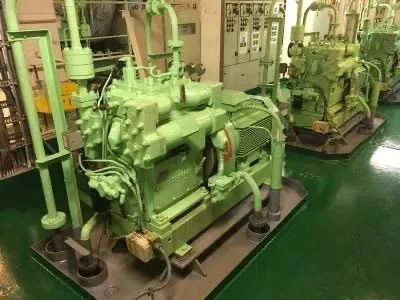Marine Air Compressors on Ships – Operation, Maintenance, and Troubleshooting
In this article, we’ll explore marine air compressors in-depth: types used onboard, their applications, operation, safety features, routine maintenance, valve overhauling, and real-world troubleshooting tips.
Types of Compressors Used Onboard Ships
Compressors onboard are used for compressing gases by reducing volume and increasing pressure. There are different types of compressors based on design and purpose:
1. Types by Design:
- Reciprocating Compressors – Most common onboard; robust, reliable, ideal for high-pressure air.
- Rotary Screw Compressors
- Rotary Vane Compressors
- Centrifugal Compressors
Note: For high-pressure applications (above 7 bar), reciprocating compressors are preferred due to better sealing and staged compression.
2. Types by Application:
- Main Air Compressor: Supplies high-pressure air (typically 30 bar) for starting main and auxiliary engines.
- Control Air Compressor: Supplies low-pressure air (~7 bar) for automation and pneumatic control systems.
- Topping-Up Compressor: Maintains air pressure in bottles by compensating for leakage.
- Deck Air Compressor: Provides service air on deck.
- Breathing Air Compressor: Fills SCBA bottles; delivers clean, oil-free air.
Uses of Compressed Air Onboard
Compressed air serves numerous functions on ships:
- Starting main and auxiliary engines
- Operating automation and control systems
- Starting emergency generators and fire pumps
- Operating fog horns and whistles
- Pressurizing hydrophore tanks for domestic water
- Supporting sewage plant operation
- Driving pneumatic tools (grinders, chisels, drills)
- General cleaning and maintenance
- Assisting boiler soot blowing
- Fuel transfer via pneumatic pumps
- Lifeboat launching (air motors)
Without compressed air, many of a ship’s critical operations would come to a halt.
Why Do Compressors Need Unloaders?
Unloading is essential to protect both the compressor and its electric motor:
- At Start-Up: Prevents motor overload by reducing load during high inrush current.
- Moisture Removal: Condensed water and oil mix is incompressible and can damage internals.
- At Shut-Down: Drains out residual moisture from chambers.
- Intermittent Unloading: Removes accumulated moisture from stages.
Types of Unloaders:
- Pneumatically actuated
- Solenoid-based with timers
These systems ensure the compressor starts and stops safely, and runs dry of unwanted liquids.
Key Safety Features in Marine Compressors
Despite their reliability, compressors can pose a safety hazard if neglected. Explosions due to oil mist and cracked heads are documented incidents.
Typical Safety Devices:
- Low Lube Oil Pressure Trip
- High Cooling Water Temperature Trip
- Motor Overload and Overheating Trips
- Relief Valves at each compression stage
Always test the relief valves periodically—many are provided with hand test levers.
Operating a Marine Reciprocating Air Compressor
Before starting the compressor, follow these checks:
- Lube Oil Level – Check crankcase sump and lubricator tank.
- Unloading Lines – Must be open.
- Pressure Gauge Cocks – Slightly open to dampen needle vibrations.
- Air Filter – Should be clean and free of debris.
- Cooling System – Ensure cooling water pump and valves are functioning.
- Relief Valves – Test manually if lever provided.
- Piping – Discharge lines should be correctly aligned.
- Turn Manually – Rotate the flywheel to check for smooth movement.
Once all checks are done, start the compressor with unloaders open.
Routine Maintenance of Marine Compressors
Routine care is the key to longevity. Follow your ship’s Planned Maintenance System (PMS), but here’s a practical guide:
Daily Checks:
- Lube oil level
- Air filter cleanliness
- Unusual noise or vibration
- Temperature of discharge air and cooling water
250 Hours:
- Clean air filter – Dirty filters raise air temperature dangerously.
- Inspect and clean valves – Prevent impact and carbon build-up.
- Check V-belts – Adjust or replace as needed.
- Test unloader function
500 Hours:
- Change crankcase oil – Use correct grade; synthetic oils last longer.
- Check bearing clearances and bumping clearance
- Examine piston rings and liners
Note: Poor maintenance leads to hot surfaces and can cause oil mist explosions—a very real onboard risk.
Valve Overhauling Procedure
Marine compressors use HOERBIGER-type automatic valves. Suction and discharge valves look similar but differ in spring tension—never interchange!
Steps for Valve Overhaul:
- Electrically isolate the compressor. Remove fuses and display isolation tag.
- Dismantle valves and soak parts in kerosene/diesel.
- Clean with soft brush. Use copper scraper for tough carbon.
- Inspect valve plates and seats for cracks or wear.
- Lap valve plates and seats on a surface plate using fine grinding paste.
- Clean with compressed air.
- Assemble with correct spring and orientation.
- Test valve function with light stick pressure.
- Leak test by filling with kerosene—check for drop in level.
CAUTION: Incorrect valve reassembly or mixing suction/discharge valves can lead to overpressure and cylinder damage.
Troubleshooting Marine Air Compressors
Here are common symptoms and possible causes:
1. Low Lube Oil Pressure
- Worn bearings
- Choked oil strainer
- Faulty pressure gauge
- Gear pump failure
- Oil level too low
2. High Cooling Water Temperature
- Cooling water valves closed
- Belt of cooling pump loose
- Air lock or blocked piping
- Pump failure or no circulation
3. Unusual Noise or Vibrations
- Loose foundation bolts
- Worn out bearings or piston slap
- Valve plate broken
- Excessive crankshaft end play
4. Incorrect First Stage Pressure
- Suction valve leaking or not opening fully
- Discharge valve damaged
- Air intake filter choked
5. Incorrect Second Stage Pressure
- Suction/discharge valve leaking or wrong spring
- Piston ring leakage
- After cooler or discharge line blockage
The key is to be alert. Good marine engineers don’t just react—they sense changes early and plan their maintenance accordingly.


